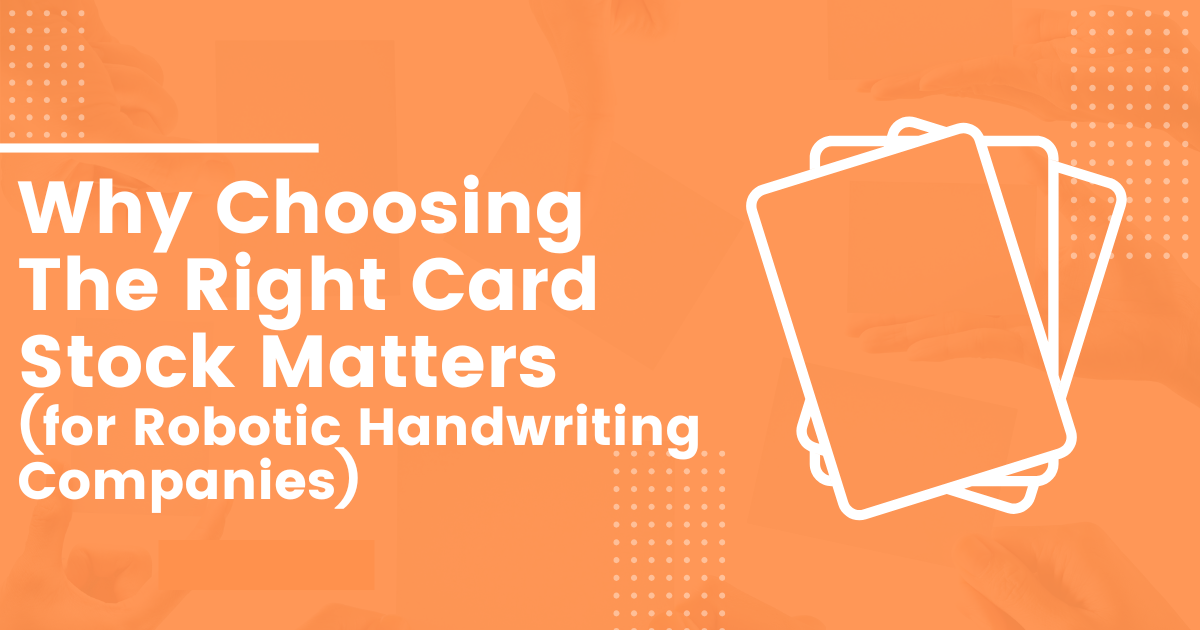Did you ever think you would read an entire blog post dedicated to card stock and it’s compatibility with ballpoint pens?
In all fairness, I never thought I would write one. 🙂
But having owned a robotic handwriting company for almost 2 years now, I can pretty much speak to all the nuances that come with this industry. And today, it’s about finding the right card stock and finish.
In fact, my analysis of over 40 different card stocks showed that 82% of common finishes create at least some writing issues with standard Bic ballpoint pens.
I’m going to talk about:
- Which card stock finishes work best with ballpoint pens (based on actual testing)
- The exact finishes to avoid (and why)
- Pro tips for choosing the perfect card stock
Let’s talk paper!
Why Most People Choose the Wrong Card Stock Finish
Here’s something crazy:
Most people select card stock based on how it looks, not how it performs with pens. This makes sense but is also a HUGE mistake.
If you’re considering printing something that will have a handwritten message (either written by yourself or one of our robotic handwriting machines) then you’ll want to read on.
The Best Card Stock Finishes for Ballpoint Pens (Ranked by Performance)
After testing over 40 different finishes with a standard Bic ballpoint pen, here is how I would rank card stock finishes:
1. Uncoated Smooth Finish
![Performance Score: 94/100]
This is the gold standard for ballpoint pens. Here’s why:
- Optimal ink absorption
- No smudging
- Consistent line quality
- Quick drying time
Pro Tip: Avoid textured finishes and go for”smooth” designations on uncoated stock.
2. Lightly Coated Matte
![Performance Score: 88/100]
The perfect balance between aesthetics and functionality:
- Good ink absorption
- Minimal show-through
- Professional appearance
- Slight texture for grip
3. Eggshell Finish
![Performance Score: 85/100]
A surprisingly excellent choice that offers:
- Natural feel
- Superior ink flow
- Reduced glare
- Professional look
Finishes to Avoid (And Why)
Let’s get real:
Some finishes should be 100% avoided if you want to use robotic handwriting services including:
High Gloss
⚠️ Performance Score: 32/100
- Ink pooling
- Excessive smudging
- Long dry times
- High smear risk
Heavy Coating
⚠️ Performance Score: 41/100
- Ink beading
- Inconsistent lines
- Poor absorption
- Surface scratching
Other Considerations Robotic Handwriting Companies Should Consider
Since our machines need to “feed” the paper to be written on, we are also taking into consideration:
- Paper Thickness– Paper too thick is hard to feed as well as paper that is too thin. The right weight we have found is right around 130# or 17pt card stock. (Variations such as 16pt or 18pt work well, too!)
- Paper Characteristics– Some of our clients like the fancy paper that include embossed or debossed elements which can be tricky for our feeder. While these are nice and can be included when using robotic handwriting services, we recommend placing these elements where they won’t interfere with the feeding.
Lastly, here are some other best practices when consider which card stock finish to use with handwritten letters:
- Test Before Bulk Purchase– Request samples from a printing company which usually includes all types of coatings, finishes, and thickness level with the pen you intend on using.
- Consider Environmental Factors– Having the right temperature affects ink flow (think warmer means higher viscosity), humidity can impact drying if you’re considering using a robot handwriting company near bodies of water, and consequently, it also affects storage if everything is housed in a humid environment.
The Bottom Line
Choosing the right card stock finish for ballpoint pens will make all the difference when running your handwritten campaign.
When in doubt, uncoated smooth finish is your safest bet.
Interested in working with a robot handwriting company that even cares about the finish of card stock and how it will affect your campaign? We’d love for you to book a call with us to discuss your goals!

